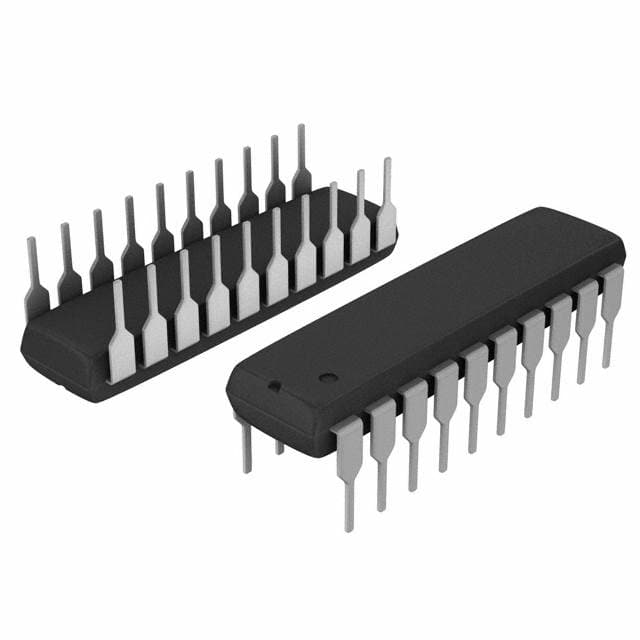Encyclopedia Entry: 74ABT373CPC
Product Overview
Category
The 74ABT373CPC belongs to the category of integrated circuits (ICs) and specifically falls under the category of flip-flops.
Use
This IC is commonly used in digital electronics for storing and transferring data. It functions as an octal transparent latch with 3-state outputs.
Characteristics
- Octal transparent latch
- 3-state outputs
- High-speed operation
- Low power consumption
- Wide operating voltage range
Package
The 74ABT373CPC is available in a 20-pin plastic dual in-line package (DIP).
Essence
The essence of the 74ABT373CPC lies in its ability to store and transfer data efficiently, making it an essential component in various digital systems.
Packaging/Quantity
The 74ABT373CPC is typically packaged in reels or tubes, with each reel containing a specific quantity of ICs. The exact quantity may vary depending on the manufacturer's specifications.
Specifications
- Supply Voltage Range: 4.5V to 5.5V
- Input Voltage Range: 0V to VCC
- Output Voltage Range: 0V to VCC
- Operating Temperature Range: -40°C to +85°C
- Maximum Clock Frequency: 125 MHz
- Output Current: ±24 mA
Detailed Pin Configuration
The 74ABT373CPC has a total of 20 pins, each serving a specific function. The pin configuration is as follows:
- D0 (Data input 0)
- D1 (Data input 1)
- D2 (Data input 2)
- D3 (Data input 3)
- D4 (Data input 4)
- D5 (Data input 5)
- D6 (Data input 6)
- D7 (Data input 7)
- GND (Ground)
- OE (Output enable)
- CP (Clock pulse)
- LE (Latch enable)
- Q0 (Output 0)
- Q1 (Output 1)
- Q2 (Output 2)
- Q3 (Output 3)
- Q4 (Output 4)
- Q5 (Output 5)
- Q6 (Output 6)
- Q7 (Output 7)
Functional Features
The 74ABT373CPC offers the following functional features:
- Octal transparent latch with 3-state outputs
- Data inputs (D0-D7) for storing data
- Output enable (OE) for enabling/disabling the outputs
- Clock pulse (CP) for latching the data inputs
- Latch enable (LE) for controlling the latching operation
Advantages and Disadvantages
Advantages
- High-speed operation allows for efficient data transfer
- Low power consumption helps in reducing energy usage
- Wide operating voltage range provides flexibility in various applications
Disadvantages
- Limited number of outputs (8) may restrict certain applications requiring more outputs
- Sensitive to electrostatic discharge (ESD), requiring proper handling and precautions
Working Principles
The 74ABT373CPC operates based on the principles of flip-flops. When the latch enable (LE) signal is high, the data inputs (D0-D7) are transferred to the outputs (Q0-Q7) upon receiving a clock pulse (CP). The output enable (OE) signal controls whether the outputs are active or in a high-impedance state.
Detailed Application Field Plans
The 74ABT373CPC finds extensive use in various digital systems and applications, including:
- Microprocessors and microcontrollers
- Data storage devices
- Communication systems
- Industrial automation
- Automotive electronics
Detailed and Complete Alternative Models
There are several alternative models available that offer similar functionality to the 74ABT373CPC. Some notable alternatives include:
- 74HC373: High-speed CMOS octal D-type latch with 3-state outputs
- CD74ACT373: Octal transparent latch with 3-state outputs and TTL-compatible inputs
- SN74LS373: Octal D-type transparent latch with 3-state outputs and LS-TTL-compatible inputs
These alternative models can be considered based on specific requirements and compatibility with existing systems.
In conclusion, the 74ABT373CPC is a versatile integrated circuit used for data storage and transfer in digital systems. Its high-speed operation, low power consumption, and wide operating voltage range make it suitable for various applications. Proper handling and consideration of alternative models can enhance its effectiveness in different scenarios.
Lista 10 Vanliga frågor och svar relaterade till tillämpningen av 74ABT373CPC i tekniska lösningar
Sure! Here are 10 common questions and answers related to the application of 74ABT373CPC in technical solutions:
Q: What is the 74ABT373CPC? A: The 74ABT373CPC is a transparent latch with 3-state outputs, commonly used in digital circuits.
Q: What is the purpose of the 74ABT373CPC? A: The 74ABT373CPC is used to store and control the flow of data in a digital system.
Q: How many bits can the 74ABT373CPC store? A: The 74ABT373CPC can store 8 bits of data.
Q: What is the difference between a latch and a flip-flop? A: Latches are level-sensitive and can change their output as long as the enable signal is active, while flip-flops are edge-triggered and change their output only on clock edges.
Q: How do I connect the 74ABT373CPC in my circuit? A: Connect the data inputs (D0-D7) to your data source, connect the enable input (G) to your control signal, and connect the outputs (Q0-Q7) to your destination.
Q: Can I use the 74ABT373CPC for bidirectional data transfer? A: No, the 74ABT373CPC is unidirectional and can only transfer data from inputs to outputs.
Q: What is the maximum operating frequency of the 74ABT373CPC? A: The maximum operating frequency of the 74ABT373CPC is typically around 200 MHz.
Q: Can I cascade multiple 74ABT373CPCs to increase the number of stored bits? A: Yes, you can cascade multiple 74ABT373CPCs to increase the number of stored bits in your system.
Q: What is the power supply voltage range for the 74ABT373CPC? A: The 74ABT373CPC operates with a power supply voltage range of 4.5V to 5.5V.
Q: Are there any precautions I should take when using the 74ABT373CPC? A: Yes, ensure that the input and output voltages are within the specified range, avoid exceeding the maximum operating frequency, and follow proper grounding techniques to minimize noise interference.
Please note that these answers are general and may vary depending on specific application requirements and datasheet specifications.


